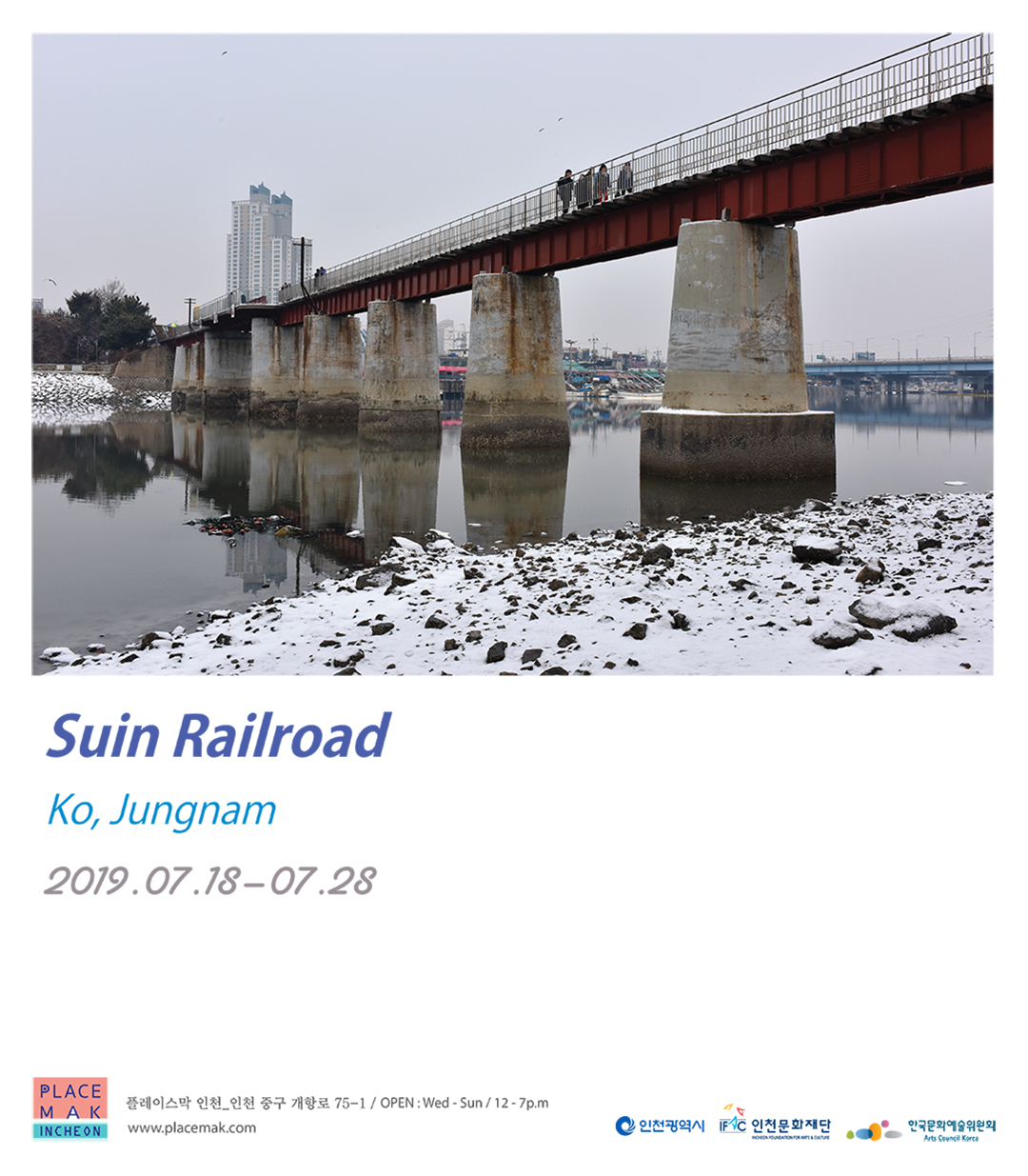어디에나 있는, 그러나 어디에도 없는 우리 안의 수인선
아무도 가려 하지 않았다. / 아무도 간 사람이 없었다. // 처음엔 바람이 비탈길을 깎아 흙먼지를 풀풀 날리었다. / 하늘을 깎고 어둠을 깎고 눈(雪)의 살을깎는 소리가 떨어졌다. / 산도 숲속에 숨어 있었다. / 얼음도 깎인 벼의 밑둥을 붙잡고 놓지 않았다. / 매 한 마리가 산까치를 움켜잡고 하늘 깊숙이 파묻혔다. / 얼음장 위로 얼굴을 내밀었던 은빛 햇살도 사라졌다. / 묘지에 서로 모여 갈대가 울었다. 그 속으로 눈발이 힘없이 쓰러졌다. / 어둠이 하얗게 질린 얼굴로사위어 있었다. / 뒤엉켜 죽은 망초꽃들이 휘익휘익 공중에서 말하고 지나갔다. / ‘그것봐’ ‘그것봐’ / 황토빛 자갈이 주르르 넘어졌다. 구르고 지난 자리마다사정없이 눈(雪)이 꽂혔다. - 기형도, <사강리(沙江里)>
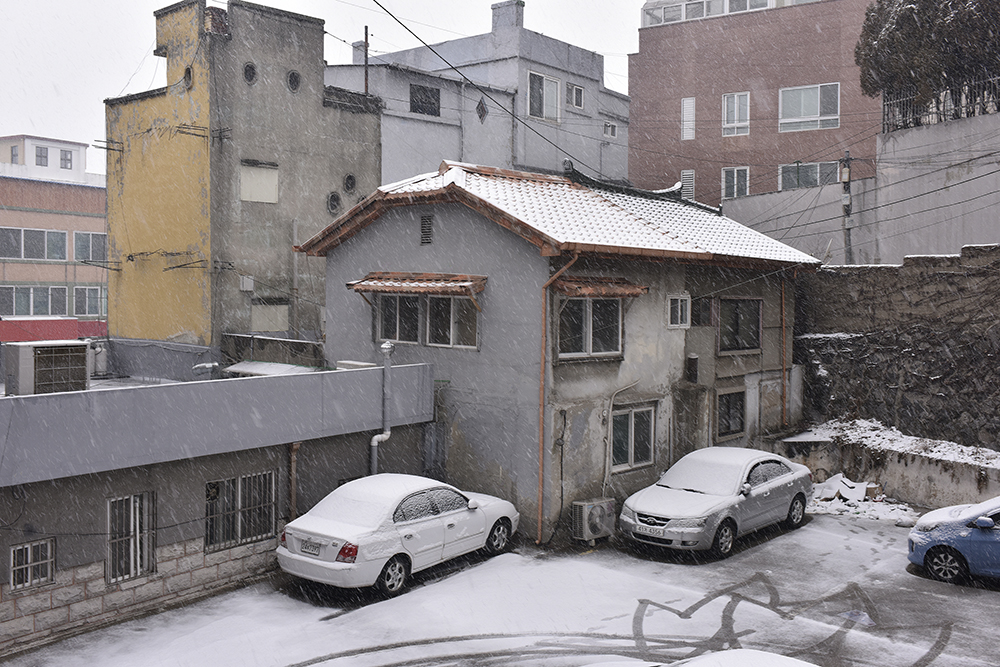
Suin Railroad#01_아카이벌 피그먼트 프린트__50.5x77.5cm_2018
수인선 1
멋도 모르고 부모님 손에 이끌려 그대로 주저앉아 살게 된 인천. 인천은 우리 가족이 살던 서울 구로동과 크게 다르지 않았다. 신기하게도 그곳처럼 먼지로 뒤덮인 회색 벽이 있었고, 집 앞에는 부지런히 흰 연기를 내뿜는 공장 굴뚝이 있었고, 어른들이 타박하던 우리들의 좁다란 골목이 있었다. 그리고 그저 텅 비어 있어 늘 나른하게 보이는 공터가 있는 것도 같았다. 하지만 어느 날 찾은 소래는 달랐다. 그곳은 황량한 노란색과 빛바랜 회색, 그리고 펄 속의 이름 모를 식물들이 내뿜는 기묘한 붉은색으로 내 기억에 남아 있다. 볕이 아찔하도록좋았던 어느 여름날, 어린 눈에도 좁아 보이는 궤도를 비틀거리듯 느릿느릿 무거운 몸짓으로 어슬렁거리던 꼬마 열차가 있었다. 회색빛 바닷물이 개울처럼 흐르는 낡은 철교 위에서사람들이 느릿한 열차를 피해 종종걸음을 쳤다. 나는 “저 열차에 치어도 사람이 죽을까.”라고 생각했던 것 같다. 어느 곳이 목적지였는지는 기억에 없다. 기차를 기다리곤 했던 소래역과 송도역에서 풍기던 진득하고 저릿한 짠내는 지금도 그곳의 기표로 나에게 남아 있다. 이제야 그것이 고단해서 짜디 짤 수밖에 없는, 우리네 삶을 닮은 젓갈의 냄새였음을 안다. 그렇게 나와 수인선의 기나긴 인연은 시작되었다.
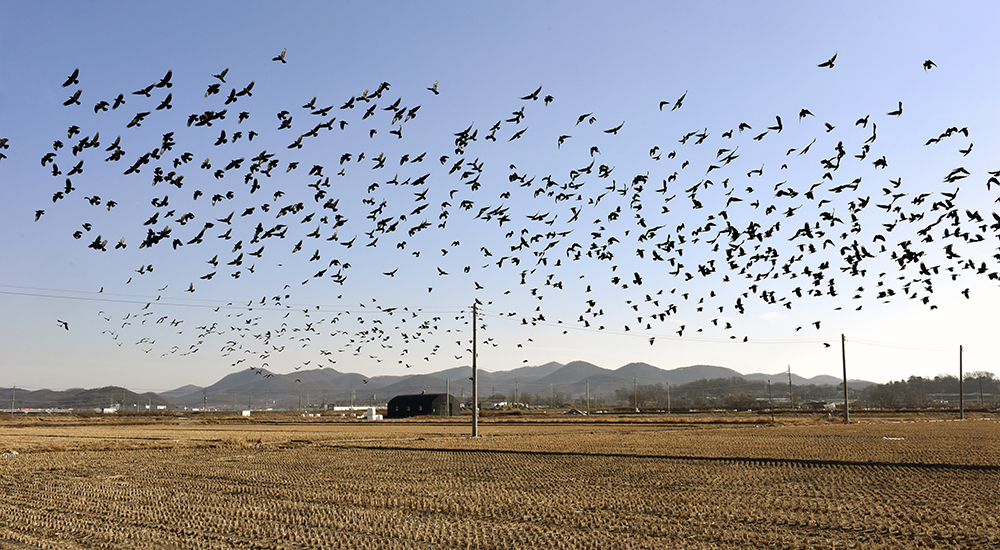
Suin Railroad#03_아카이벌 피그먼트 프린트__55x100cm_2019
수인선 2
지형이 호랑이의 아가리처럼 생겼다고 이름 붙여진 호구포. 그곳에 ‘새로 만든 수인선’ 역 중의 하나가 들어섰다. 내가 호구포역 근처로 이사한 때는 서른이 넘어서였다. 복선화가 됐다는 수인선은 역시나 황량했다. 해질녘이면 저 멀리 타는 듯한 서쪽 하늘을 배경으로 송도신도시의 실루엣이 유령처럼 다가왔다. 이제 막 지은 집 특유의 역한 냄새가 점령한 임대아파트 14층에서 내려다보이는 호구포는, 냄새 나는 물가에 아무렇게나 막 자란 풀들과 그 누추함을 있는 힘 다해 감추려는 듯한 근린공원의 반듯함이 기묘하게 공존하고 있었다. 그곳에 포구가 있었다는 사실은 간신히 역사(驛舍)의 네온 간판을 통해 유추할 수 있을 뿐이었고, 실은 수인선 어느 곳에서나 대면하게 되는 획일적인 부조화와 그로 인한 생경함만 가득했다.
촌스러운 ‘남동공단역’이 아니라 국제적 품격을 지닌 이름인 ‘남동인더스파크역’ 쪽에서 바람이라도 불라치면 시큼함과 매캐함이 섞인 냄새가 아파트 창틈으로 스멀스멀 비집고 들어왔다. 냄새라면 남동공단의 그것과 품격 있는 남동인더스파크의 그것이 다르지 않았다. 4년의 임대기간 동안 나는 ‘여전히’ 공사 중인 수인선을 오고가는 전동차에 몸을 싣고 남동공단을 지나 원인재와 연수를 거친 후 송도역에서 내려 일터가 있는 인천역 부근까지 버스로 이동하고는 했다. 마침내 지금은 공사가 끝났으므로 인천역에 이르는 철길까지 우리는 수인선이라고 부를 수 있다. 그곳에 계속 살고 있었다면 버스 따위는 타지 않았으리라.
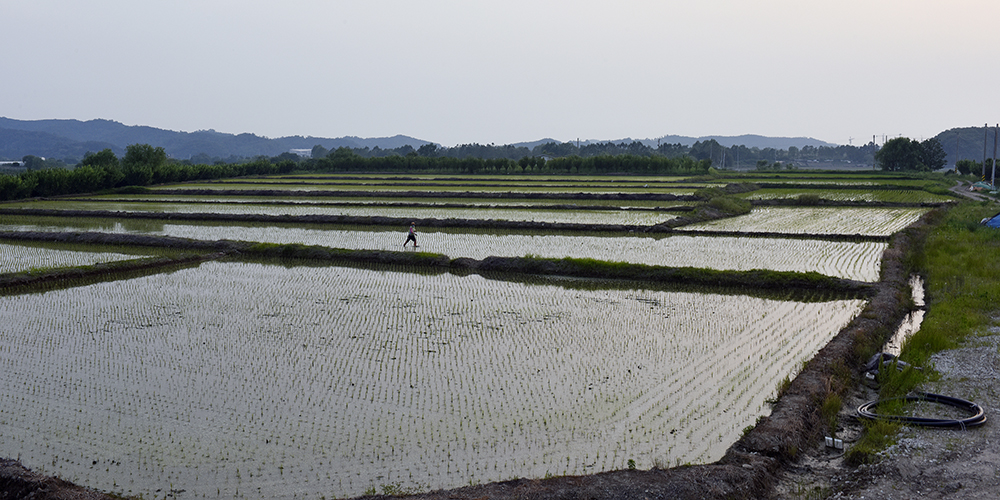
Suin Railroad#04_아카이벌 피그먼트 프린트__45x90cm_2018
고정남, 그리고 수인선
고정남의 《수인선》 시리즈를 대했을 때, 나는 그의 사진들이 전해주는 이미지에 집중하기보다 거기서 풍기는 듯한 냄새에 먼저 반응했다. 예전에 알던 젓갈의 비릿한 냄새도, 개펄의짠내도 아니었다. 뙤약볕이 한창이던 시골역사 한켠에 구부정하게 서 있던 수양버들 그늘이 발산하던 싱그러운 냄새도 아니었다. 그의 사진 <야목역>의 덤프트럭이 지날 때마다 바람에 풀풀 날리는 바싹 마른 먼지 냄새였고, 고색역과 봉담역을 찍은 사진이 담고 있는 축축한 콘크리트 내음이었다. 허나 사실 이 냄새는 딱히 수인선과 맞닿아 있지는 않다. 지금, 여기에 살고 있는 사람이라면 익숙하다 못해 친근한, ‘건설’ 이미지의 후각적 표징일 것이다. 그러므로 그의 사진에서 풍기는 냄새는 우리에게 보편적이다. 한때 아낙들이 건져 올렸을조개 같이 비릿한 것들은 이제 트럭의 억센 바퀴 밑에서 산산조각이 나고(<야목역>), 어천역 주변에 뒹구는 이정표에 새겨진 ‘반월’ 지명도 처연하다. 그뿐인가. 송도역 한편에 오래도록 방치되었음이 분명한 물탱크 혹은 기름탱크는 이미 식물의 왕성한 생명력을 과시하는 장으로 변화한 지 오래다. 새로운 노선을 만들었으므로 이제 더 이상 쓰이지 않는 야목역의교각과 철교는 폐사지처럼 허허로운데, 저 멀리 효율적인 용적률을 자랑하는 대규모의 고층아파트단지와 묘한 대비를 이루고 있다. 그의 카메라는 물끄러미 그런 광경을 담아낼 뿐이다. 그와 같은 걸 느끼라고 강요하지 않는다, 다만 제시할 뿐.
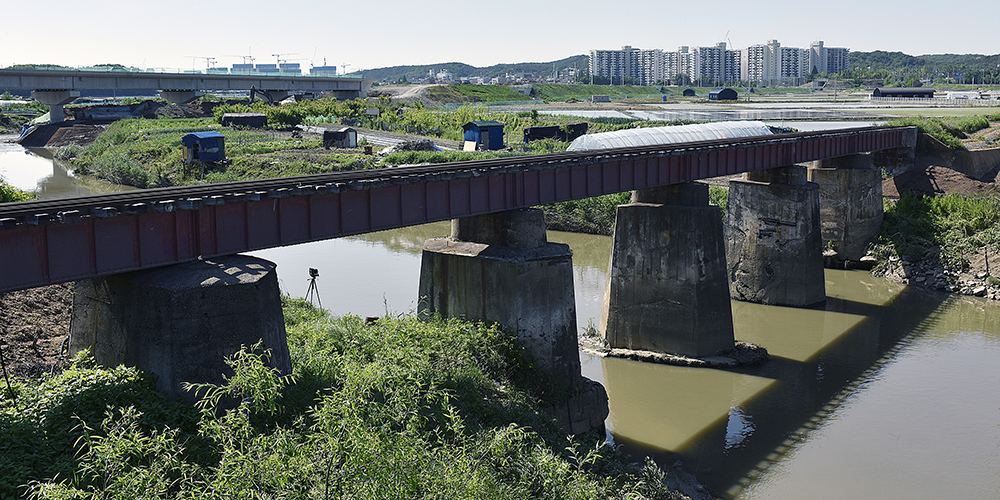
Suin Railroad#05_아카이벌 피그먼트 프린트__45x90cm_2018
고정남, 수인선, 그리고 사람들
다소 건조한 이야기. 수인선은 이름대로 당연히 수원과 인천을 잇는다. 그 중간에는 안산과 시흥을 지난다. 1995년 12월을 마지막으로 운행을 중단했다가 20년 만에 다시 탄생했다. 워낙에 수인선은 일제강점기에 여주와 수원을 잇던 ‘수려선’을 통해 싣고 왔던 그 좋은 여주쌀과 소래염전에서 생산된 천일염을 인천항을 통해 일본으로 반출하기 위한 산업철도로 놓였다. 보통 철도에 비해 폭이 절반 정도였기에 협궤열차, 꼬마열차로 불렸다. 해방이 왔고, 수인선은 이제 인천과 수원 사이의 넓은 빈터, 아무 것도 없어서 황량하리만치 넓었던 경기남부의 소도시들을 관통하며 도시의 느린 변화를 바라보았다. 바야흐로 사람을 실어 나르는, 하여 사람들의 질펀한 이야기가 꽃을 피우는 수인선의 이야기가 시작되었다. 길이 있는곳에 어찌 사람의 이야기가 빠질 수 있을까. 고정남의 카메라는 그런 사람들의 이야기로 시선을 옮긴다. 그것도 수인선의 역사가 베인 사람들의 이야기다. 그래서 그의 사진에 등장하는 인물들은 그대로 《수인선》 이야기의 한 부분이 된다. <신포역>에 등장하는 중년의 남성은 적산가옥으로 보이는 일본식 집을 배경으로 하고 있다. 집 앞에는 이제 공사를 막 시작하려는지 건설자재와 중장비가 보인다. 고정남은 ‘신포역’이라는 역사의 이름을 소환하는 동시에 한 남성의 모습을 중첩시킴으로써 우리에게 근대는 무엇인가라는 질문을 던지는지도모른다. <신포역>의 또 다른 사진 한 장. 중학생쯤으로 보이는 소녀가 강아지를 안고 엷은 미소를 띤 채 카메라를 응시한다. 오래되어 원래의 구조가 바뀌기에 이른 세월의 더께와 싱그러운 미소를 보이는 소녀의 극적 대비가 오히려 심상하다. 그런 식이다. 그는 그저 제시한다.
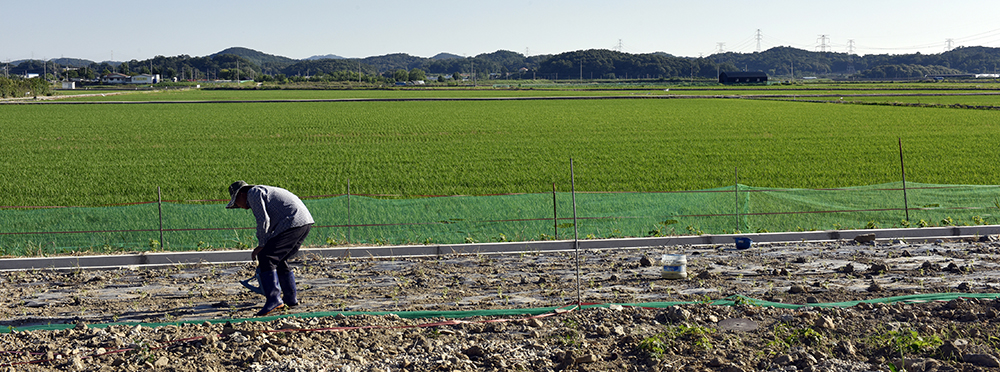
Suin Railroad#06_아카이벌 피그먼트 프린트__33.5x90cm_2019
<인천역>에 포착된 중년 남성 옆에 놓인 짐수레에는 ‘일본통운(日本通運)’ 로고가 선명하다. 이를 통해 인천역의 역사적 맥락을 자연스레 보여줄 뿐이다. 그러므로 ‘중년 남성의 초상’은 ‘일본통운’이라는 기호를 돕는 장치로 작용한다. <원인재역> 속 3명의 아시아계 이주노동자는 더 이상 쓰이지 않는 옛 수인선 철교의 교각과 그 밑의 무성한 잡초를 배경으로서 있다. 마치 유명한 관광지에서 찍은 기념사진처럼 그들은 ‘성의껏’ 포즈를 취하고 있다. 지나치게 진지해서 오히려 우습지만, 이 역시 수인선을 오가는 사람들의 삶임을 우리는 알고 있다.
그 밖에도 수인선을 따라 농사짓는 사람들이 갑자기 툭툭 튀어나오곤 하는데, <어천역>의 젊은 도시농부가 그렇고, <월곶역>의 노인과 부부들이 그렇다. 수인선 특유의 산업화된 모습과 전통적 생활방식이 혼재된 모습은 그대로 우리 사회의 단편으로 보인다. 고정남은 그들을 아무런 편견 없이 담아낸다.
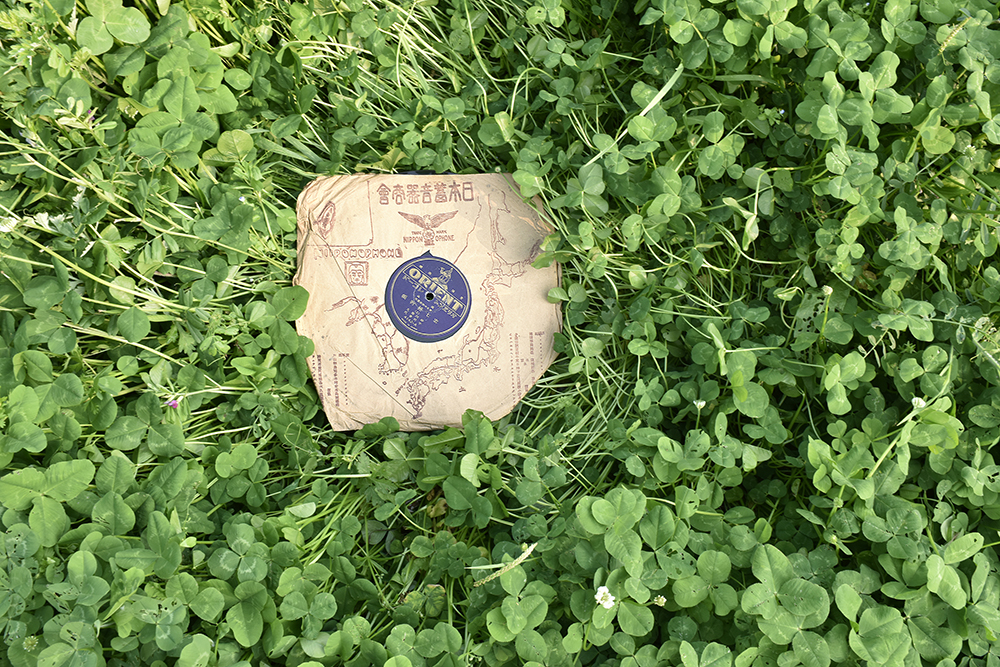
Suin Railroad#07_아카이벌 피그먼트 프린트__50.5x77.5cm_2018
고정남은 결코 ‘폼 잡지 않고’ 우리의 굴절된 근대와 급속도로 진행된 현대의 단편적인 이미지들을 수집하고 버무린다. 그렇다고 그의 사진이 만만한 것만은 아니다. 이를테면 그는 그의 역사적 인식을 보여주는 최소한의 연출을 시도하거나, 개발과 그 속에 도사린 자본의 욕망을 드러내는 장면을 선택한 사진을 제시하기도 한다. <원인재역> 중 잡초 속에 놓인 레코드판 표지는 한반도와 일본열도가 중앙에, 주변에는 ‘일본축음기상회(日本蓄音機商會)’ 지점의 현황이 인쇄되어 있다. 이는 전작인 《호남선》 시리즈에서 1921년에 발행된 호남관광안내도를 제시한 것을 떠올리게 하는 바, ‘일본축음기상회’ 레코드판 표지를 통해 수인선 건설의 역사적 배경을 자연스레 전해준다. <사리역>에서는 농작물 재배를 위해 밭고랑에 설치한 막을 주변의 학원 현수막을 이용한 모습을 보여줌으로써 은근히 성장·경쟁 중심의 이 사회에 야유를 보내는 듯하다. 하지만 여전히 그 방식은 결코 무겁지 않다.
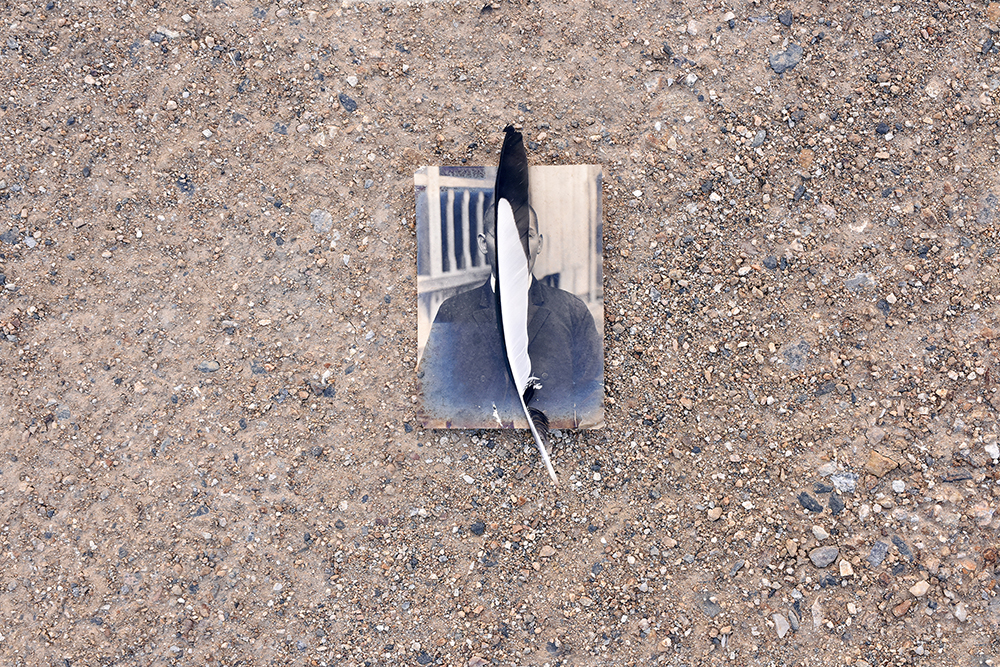
Suin Railroad#08_아카이벌 피그먼트 프린트__50.5x77.5cm_2018
어디에나 있되, 어디에도 없는 풍경
고정남이 보여주는 《수인선》 시리즈는 철길과 그 주변 사람들에 대한 유쾌하지만 묵직한 일종의 시각적 보고서다. 수인선이라는 소위 ‘변두리’는 서글픈 근대의 기억과 그로 인한 집단의 욕망이 혼재되었으나, 여전히 그에 기댄 삶이 계속되고 있는 우리 사회의 축소판으로 보인다. 그것이 ‘중앙’의 세련되고 정제된 방식이 아니므로 더욱 눈에 띌 뿐이다. 서두에 인용한 기형도의 시 <사강리>의 어수선하고도 스산한 풍경이 이와 같았을까? ‘바람이 비탈길을 깎아 흙먼지를 풀풀 날리’는, ‘황토빛 자갈이 주르르 넘어’지는 서걱거리는 풍경은 오늘도 수인선 전동차 창밖에 펼쳐진다. 고정남은 그 흔한 우리의 풍경을 성실한 소요자의 시선으로 기록한다. 그러므로 기형도의 펜과 고정남의 눈을 통해 보는 수인선의 풍경은 우리 주변 어디에나 있으되, 어디에도 없다. 이제 우리도 늘 존재해 왔지만 한 번도 의미를 지녀 본 적 없는 저마다의 풍경을 만들어 봐도 좋지 않을까. 여기와 저기를 잇다가 마침내 사람의이야기로 가득해진 좁고 느릿한 기차처럼.
박석태(미술비평)
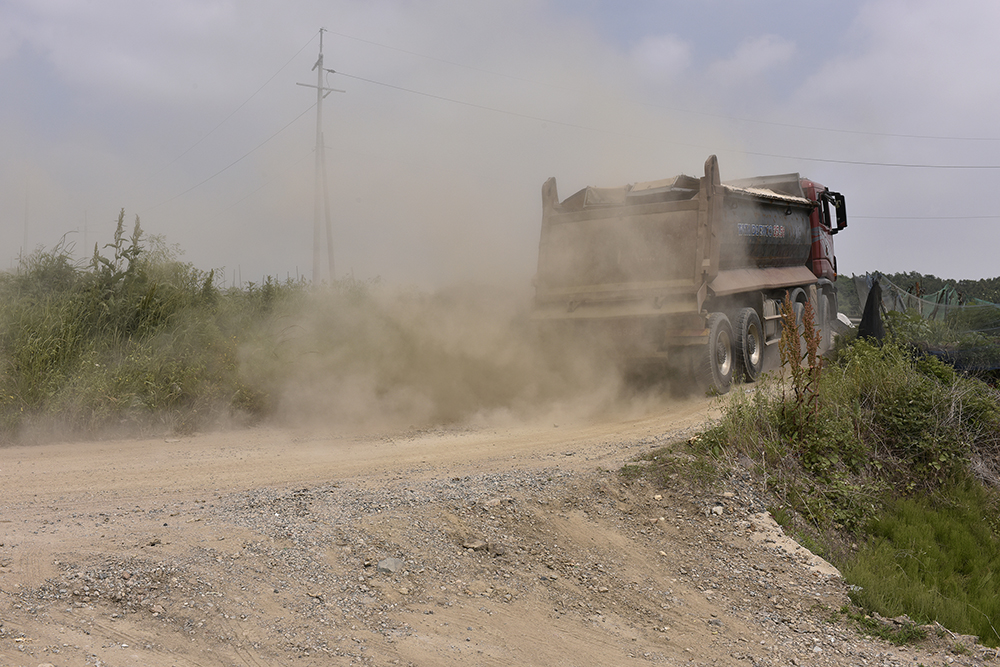
Suin Railroad#09_아카이벌 피그먼트 프린트__50.5x77.5cm_2018
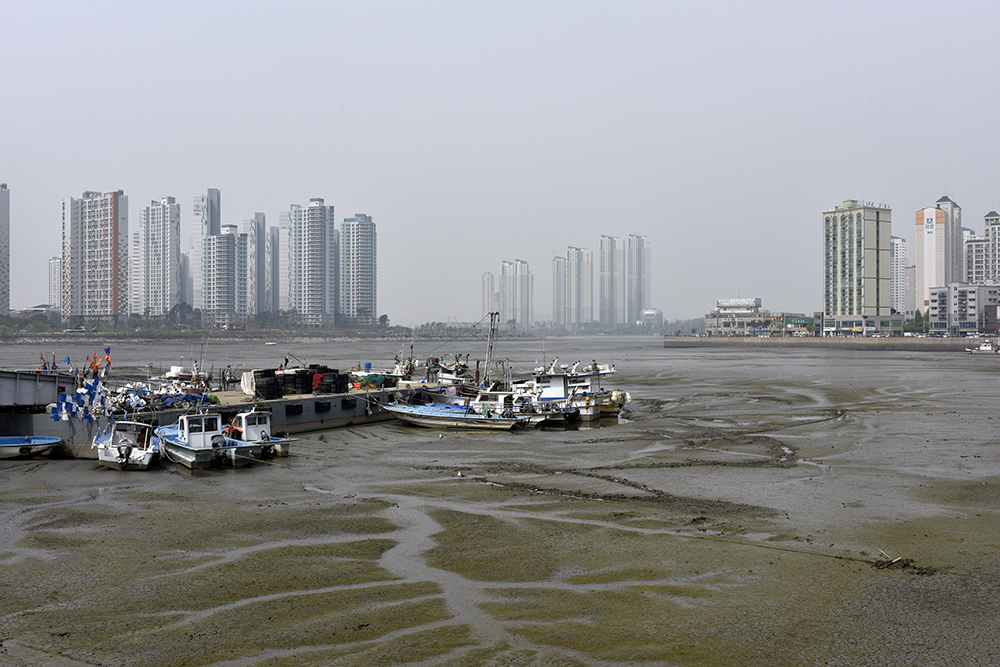
Suin Railroad#10_아카이벌 피그먼트 프린트__50.5x77.5cm_2018
Suin Line Inside Us That is Anywhere but Also Nowhere
Suin Line 1
I was simply led by my parents and ended up living in Incheon without thinking too much. Incheon was not very different from Guro-dong, Seoul, where my family used to live. Strangely enough, there were a gray wall covered in dust, a factory chimney in front of my house working hard to puff out white smoke, and our narrow alley which adults criticized. And there was an open space that was always empty and relaxing, too.
However, I visited Sorae one day and found it quite different. It remains in my memory as bleak yellow, faded gray, and peculiar red colors that unknown plants in the mudflat. On a beautiful sunny day in the summer, there was a little slow-moving train that wandered, staggering the railroad that seemed narrow even to a young child. On an old railroad bridge where the gray seawater flew like a brook, people often trotted to move away from a slow train. I believe I thought, " "Will anyone die when they get hit by that train?"
I do not remember where my destination was. The deep, fuzzy salty tang of Sorae Station and Songdo Station, where I used to wait for the train, is still in my memory as the symbol of the places. Now I know that it was the smell of salted seafood resembling our life, which is salty due to the harshness. This is how my long relationship with Suin Line began.
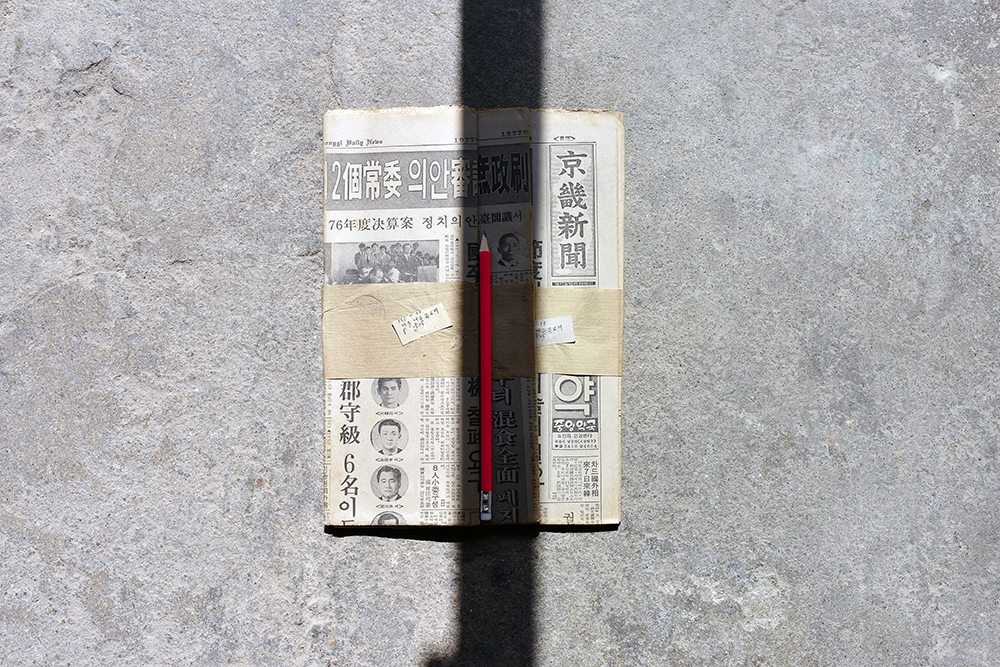
Suin Railroad#11_아카이벌 피그먼트 프린트__50.5x77.5cm_2018
Suin Line 2
Hogupo was named for its terrain that looks like a tiger's mouth. One of the 'newly created Suin Line' stations was developed there. I was over thirty when I moved near Hogupo Station. Suin Line, which became a double-track line, was obviously bleak. At sunset, the silhouette of Songdo New City appeared like a ghost in the backdrop of the western sky. Hogupo, when overlooked from the 14th floor of a rental apartment with a strong smell of newly-built buildings, grass grown carelessly at the smelly waterside and the organized look of the neighboring park which seemed to hide such raunch coexisted in a strange way. I could only infer that there was a port there through the neon sign of the station, and in fact it was full of uniform incongruity and life experiences led by it that I could encounter anywhere in Suin Line.
When the wind blows in from 'Namdong Induspark Station', which sounds internationally renowned, not shabby 'Namdong Gongdan Station', the sour and smoky smell came into the apartment through the windows. In terms of smell, the one of Namdong Gongdan was not that different from that of the classy Namdong Induspark. During my four-year rental period, I hopped on the subway passing Suin Line which was “still” under construction, going through Namdong Gongdan, passing through Woninjae Station and Yeonsu Station, then got off at Songdo Station and took the bus to Incheon Station near my work. Finally, since the construction is over now, we can call the railroad to Incheon Station “Suin Line.” If I had still lived there, I would not take the bus.
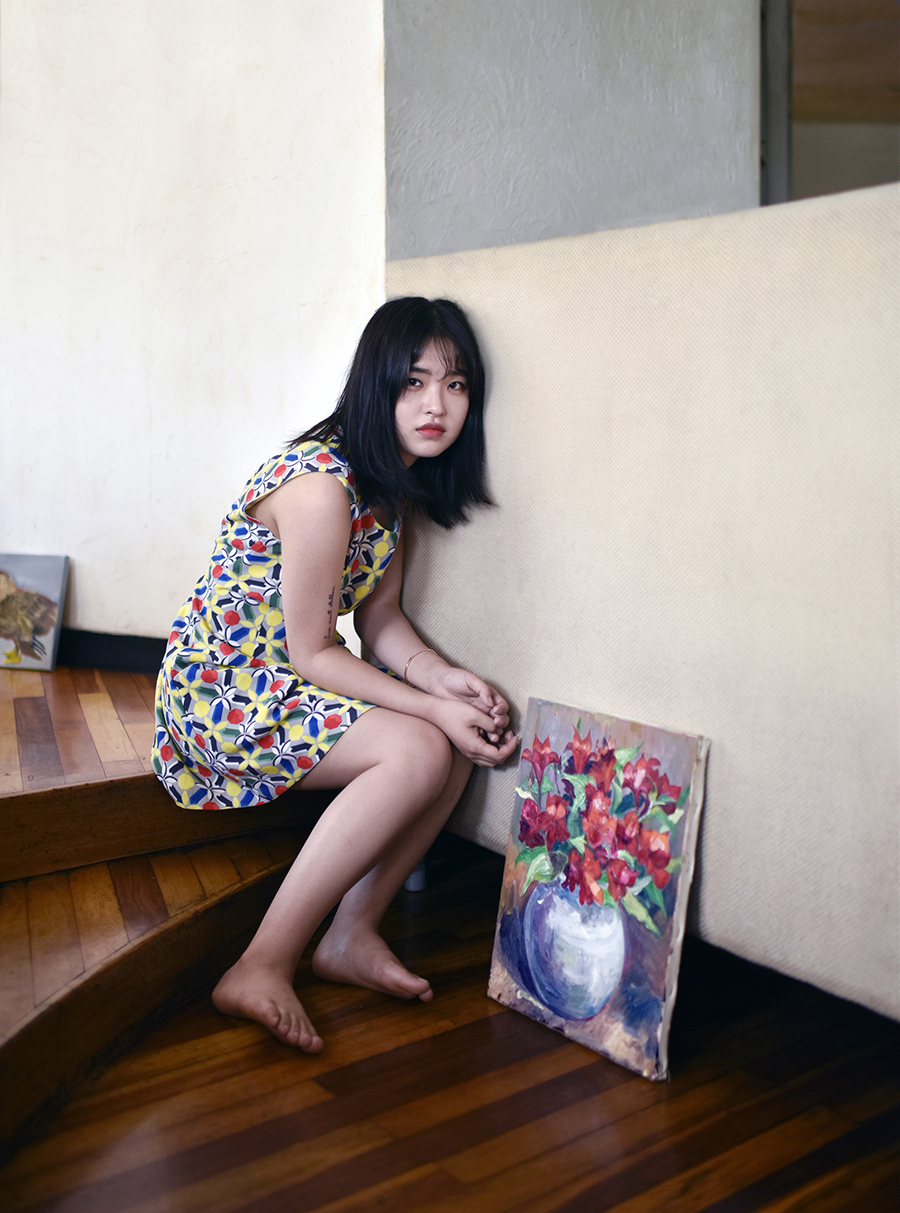
Suin Railroad#12_아카이벌 피그먼트 프린트__77.5x50.5cm_2018
Ko, Jung-nam, and Suin Line
When I saw the "Suin Line" series, I responded to the imaginary smell from them first, rather than concentrating on the images of his photographs. It was neither the fishy smell of salted fish nor salty smell of the foreshore that I knew before. It was not the fresh smell from the shadow of weeping willow that stood somewhere in a countryside station where the sunshine was in full bloom. It was the smell of dry dust blowing in the wind every time a dump truck in his photo "Yamok Station" passed, and it also was the smell from damp concrete with photos of Kosaek Station and Bongdam Station. However, the smell does not really touch Suin Line. It would be the olfactory sign of the 'construction' image that people living here now are more than familiar to. Therefore, the smell in his photo is common to us.
Salty things like shells that women had once scooped up would now shatter under the heavy wheels of trucks. The name Banwol on the signposts around Yamok Station and Eocheon Station is plaintive. Not only that, the water tank or oil tank, which has clearly been left for long in the Songdo Station, has already changed into a place where the vitality of plants is shown off. Now that we have created a new line, the pier and railroad bridge of Yamok Station, which are no longer used, are plain just like a ruined temple site. It is a strange contrast to the large high-rise apartment complexes that boast an efficient floor area ratio. His camera only captures such spectacular scenes. He does not force you to feel like that. He just suggests.
Ko, Jung-nam, Suin Line, and People
This is a somewhat dry story. Suin Line, as its name implies, connects Suwon and Incheon. It passes through Ansan and Siheung in the middle. It was discontinued in December 1995 and was reborn in 20 years. Suin Line was placed as an industrial railway for the export of high quality Yeoju rice and solar salt from Sorae salt pond, which has been loaded through the 'Suryeo Line' which connected Yeoju to Suwon in the period of Japanese occupation, through Incheon Port. It was called a narrow-gauge train or a little train because it was about half the width of a regular railroad. Liberation came, and Suin Line penetrated small towns in southern Gyeonggi that was wide open because there was nothing between Incheon and Suwon, and looked at the slow changes in the city. Then, the story of Suin Line, which carry people and therefore make people's long stories bloom, began. Shouldn’t there be people’s stories where there are roads? Ko, Jung-nam’s camera moves its focus on such stories of people. They are the stories of those in which the history of the Suin Line permeated. Thus, the characters in his photographs are part of the Suin Line story.
Shinpo Station shows a middle-aged man with the background of a Japanese-style house that looks like a countertop house. It seems like construction is about to start as there are construction materials and heavy equipment in front of the house. Ko, Jung-nam summons the name of the history of 'Shinpo Station,' and at the same time may ask the question of what modernity is like by superimposing a male figure. This is another photo of Shinpo Station. A girl, who looks like a middle school student, stares at the camera with a little smile while holding her puppy. The dramatic contrast of the trace of time due to the old structure’s change and the girl with a cute smile is rather impressive. This is how he does it. He just suggests.
The logo “Nippon Express Co., Ltd.” is clear on the cart next to middle-aged man captured in Incheon Station. Through this, he naturally shows the historical context of Incheon Station. Therefore, 'the portrait of a middle-aged man' serves as a device to help the sign of 'Japan Express.' 3 Asian migrant workers in Woninjae Station stand in the background of an old pier of the Suin Line railroad bridge and lush weeds underneath. Like a memorial picture taken at a famous tourist destination, they are posing "sincerely." They are too sincere so rather funny, but we know this is also the life of those who pass Suin Line.
In addition, people who farm along Suin Line suddenly pop out here and there. Examples include a young urban farmer couple in Eocheon Station and elderly people and couples in Wolgot Station. The mixed appearance of Suin Line’s unique industrialized form and traditional lifestyle seems to be a short story of our society. Ko, Jung-nam brings them out without prejudice.
Ko, Jung-nam never fancifies and collects and mixes our refracted modernity and rapidly progressive, fragmentary images. In other words, he presents photographs that attempt to create a minimalistic presentation of his historical perception, or reveal the development and desire of capital. In Woninjae Station, the record cover in the weeds is printed in the center of the peninsula and the islands of Japan, and "Nipponophone Company" is printed around it. This is reminiscent of the Honam tourist map that was published in 1921 in the previous Honam Line series, and naturally gives a historical background to the construction of the Suin Line through the record cover of "Nipponophone Company". Sari Station seems to be boasting to this growth and competition-centered society by showing the scene using the school banners around in the furrows to cultivate crops. But still, it is never heavy.
Landscape That is Anywhere but Also Nowhere
Ko, Jung-nam's Suin Line series is a type of delightful but deep visual report on the railroad track and people around it. The so-called 'suburb' named Suin Line was mixed with the sad modern memory and the desire of the group. However, it still appears to be a miniature of our society, where life has continued to rely on them. It is more eye-catching because it is not a sophisticated and refined way of ‘the centre.’ Could the untidy and mysterious landscape from Ki, Hyung-do's poem quoted at the beginning of the poem <Sagangri> have looked like this? ‘Crunchy landscapes where dust is blow off from a slope cut by wind and yellow ochre pebbles roll down appear today outside the windows of the Suwon Line subway. Ko, Jung-nam records our common landscapes from the perspective of a sincere creator. Therefore, the landscape of the Suin Line seen through the eyes of Ki, Hyung-do’s pen and Ko, Jung-nam are anywhere but also nowhere around us. Now, wouldn’t it be nice if we could create our own landscapes that have always existed but have never been meaningful? Like a narrow, slow train finally filled with the stories of people after connecting here and there.
